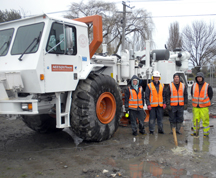Talk focuses on ways to rebuild in quake-prone New Zealand region
July 16, 2014
 |
|
Researchers are using T-Rex, a 64,000-pound shaker truck, in research to increase the resilience of homes and low-rise structures built on top of soils prone to liquefaction during strong earthquakes. T-Rex is based at a University of Texas at Austin facility that is part of the George E. Brown Jr. Network for Earthquake Engineering Simulation (NEES), a distributed laboratory with 14 sites around the United States. (image credit/NEES photo) Download Photo |
WEST LAFAYETTE, Ind. — Researchers studying methods to increase the resilience of structures built on earthquake-prone soils in New Zealand will discuss the methods during a national conference next week.
The research aims to help improve the safety of structures in Christchurch and the Canterbury region, which were devastated in 2010 and 2011 by a series of powerful earthquakes. Parts of Christchurch were severely affected by liquefaction, in which water-saturated soil temporarily becomes liquid-like and often flows to the surface creating sand boils.
The work is led by researchers Kenneth Stokoe and Brady Cox at the University of Texas at Austin's Cockrell School of Engineering.
They will talk about the research during Quake Summit 2014, the annual meeting for the National Science Foundation's George E. Brown, Jr. Network for Earthquake Engineering Simulation (NEES), a shared network of laboratories based at Purdue University. This year's summit is part of the 10th U.S. National Conference on Earthquake Engineering on July 21-25 in Anchorage, Alaska.
The researchers have conducted field trials to test shallow-ground improvement methods. They have collected data from test sections of improved and unimproved soils that were subjected to earthquake stresses using a large mobile shaker, called T-Rex, and with explosive charges planted underground. Four ground-improvement methods were initially selected for the testing: rapid impact compaction; rammed aggregate piers, which consist of gravel columns; low-mobility grouting; and construction of a single row of horizontal beams or a double row of horizontal beams beneath existing residential structures via soil-cement mixing.
Stokoe and Cox will talk about the research during a NEES Project Showcase presentation titled NEES Helping to Build a Resilient Christchurch: Towards Deep Basin Characterization and Liquefaction Mitigation.
Funding for the research has been provided, in part, by the NSF, and the New Zealand government's Earthquake Commission. NEES is a shared network of 14 experimental facilities, collaborative tools, a centralized data repository and earthquake simulation software, all linked by high-speed Internet connections.
Writer: Emil Venere, 765-494-4709, venere@purdue.edu
Sources: Kenneth H. Stokoe, 512-232-3689, k.stokoe@mail.utexas.edu
Sandra Zaragoza, UT Austin media contact, 512-471-2129, zaragoza@utexas.edu

